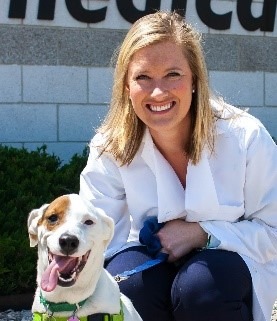-
Adopt
-
Veterinary Care
Services
Client Information
- What to Expect – Angell Boston
- Client Rights and Responsibilities
- Payments / Financial Assistance
- Pharmacy
- Client Policies
- Our Doctors
- Grief Support / Counseling
- Directions and Parking
- Helpful “How-to” Pet Care
Online Payments
Emergency: Boston
Emergency: Waltham
Poison Control Hotline
-
Programs & Resources
- Careers
-
Donate Now
 By Katherine Hogan, DVM, DACVIM (Cardiology)
By Katherine Hogan, DVM, DACVIM (Cardiology)
![]() angell.org/cardiology
angell.org/cardiology
cardiology@angell.org
617-541-5038
March 2023
x
x
Furosemide, a loop diuretic, is the most common diuretic used to treat veterinary patients with congestive heart failure (CHF). Furosemide is prescribed as the mainstay of CHF treatment alongside other vital medications (pimobendan, ACE inhibitors, +/- spironolactone); the combination of these is often referred to as “triple therapy” or “quad therapy.” Management of CHF necessitates close monitoring of renal status in conjunction with at-home monitoring (owners counting resting respiratory rates, for example) and in-clinic diagnostic testing (thoracic radiography, ultrasound assessment of effusions) for recurrence of CHF symptoms. Many patients respond favorably to standard starting doses of furosemide (~ 2mg/kg orally twice daily) for multiple months or even years without recurring CHF. However, some patients have frequent relapses and require escalation of CHF therapies due to progression of their heart disease and the development of diuretic resistance. Diuretic resistance may result from nephron hypertrophy, poor oral bioavailability, poor renal perfusion, and renin-angiotensin-aldosterone system (RAAS) activation.
prescribed as the mainstay of CHF treatment alongside other vital medications (pimobendan, ACE inhibitors, +/- spironolactone); the combination of these is often referred to as “triple therapy” or “quad therapy.” Management of CHF necessitates close monitoring of renal status in conjunction with at-home monitoring (owners counting resting respiratory rates, for example) and in-clinic diagnostic testing (thoracic radiography, ultrasound assessment of effusions) for recurrence of CHF symptoms. Many patients respond favorably to standard starting doses of furosemide (~ 2mg/kg orally twice daily) for multiple months or even years without recurring CHF. However, some patients have frequent relapses and require escalation of CHF therapies due to progression of their heart disease and the development of diuretic resistance. Diuretic resistance may result from nephron hypertrophy, poor oral bioavailability, poor renal perfusion, and renin-angiotensin-aldosterone system (RAAS) activation.
When standard therapy is not enough
When patients have a recurrence of CHF, we typically recommend increasing the furosemide dose by 25 to 50%, up to a max of ~ 8 to 12 mg/kg/day. If we rapidly escalate the furosemide dose early in CHF management OR once we reach that upper dosing range, we will be more creative with therapies.
Pimobendan
One relatively simple adjustment is to increase the pimobendan dose. Pimobendan is an “inodilator,” providing beneficial dual properties of positive inotropy and vasodilation. While off-label at doses above 0.3mg/kg twice daily, this medication has been shown to be safe up to 0.4mg/kg orally three times per day, even in cats! Anecdotal reports indicate that doses up to 1mg/kg orally three times per day have been well tolerated in dogs and may allow clinicians to administer lower doses of diuretic therapy.
Torsemide
Torsemide is a loop diuretic, similar to furosemide. It has improved bioavailability, a longer half-life, and a longer duration of action than  furosemide. Torsemide is also suspected of having aldosterone antagonism properties, which can result in anti-fibrotic effects on the myocardium and reduce diuretic resistance. Studies have determined that torsemide may have 10 to 20x more potency as a diuretic than furosemide. This may also increase the risk of azotemia or electrolyte imbalance; caution should be taken when initiating torsemide in patients with evidence of azotemia already. We typically start the torsemide dose at ~ 1/10 the patient’s current furosemide dose. For example, if a dog is receiving furosemide 12.5mg orally twice daily and we are switching to torsemide, we may recommend 1.25 to 1.5mg orally twice daily.
furosemide. Torsemide is also suspected of having aldosterone antagonism properties, which can result in anti-fibrotic effects on the myocardium and reduce diuretic resistance. Studies have determined that torsemide may have 10 to 20x more potency as a diuretic than furosemide. This may also increase the risk of azotemia or electrolyte imbalance; caution should be taken when initiating torsemide in patients with evidence of azotemia already. We typically start the torsemide dose at ~ 1/10 the patient’s current furosemide dose. For example, if a dog is receiving furosemide 12.5mg orally twice daily and we are switching to torsemide, we may recommend 1.25 to 1.5mg orally twice daily.
Hydrochlorothiazide
Hydrochlorothiazide (HCTZ) is a thiazide diuretic that reduces membrane permeability to Na+ and Cl– in the distal convoluted tubule, leading to increased Na+, Cl-, and water delivery into the collecting duct. HCTZ has good oral absorption, works within 1 to 2 hours, and has a longer half-life (6 to 12 hours) than furosemide. One significant benefit to adding HCTZ is that this medication can synergistically be used with loop diuretics due to sequential nephron blockade. It also is beneficial in reducing diuretic resistance by blocking sodium reabsorption at the distal convoluted tubule where loop-associated hypertrophy occurs. Given its potential for causing significant electrolyte disturbances or nephrotoxicity, especially in combination with other diuretics, low doses are typically started (e.g., 6.25mg orally every 72 hours in cats; 0.5 to 1 mg/kg orally once daily in dogs) and titrated based on response. We recommend closely monitoring renal values and electrolytes once this medication is started, typically rechecking lab work after the fourth dose of medication, then every few weeks until trends are established.
Afterload reduction
In addition to more commonly administered vasodilators (ACE inhibitors, pimobendan), arteriolar dilators can be utilized for afterload reduction. These allow for increased forward blood flow, especially in patients with severe mitral regurgitation. During the acute CHF setting, IV arteriodilators (nitroprusside, hydralazine) can be beneficial in combination with standard therapy. For long-term management of refractory heart failure, oral options such as amlodipine have successfully reduced afterload. Amlodipine, a dihydropyridine calcium channel blocker, helps to relax systemic arteriolar smooth muscle. This medication can be a beneficial addition in chronic heart failure management in dogs who are normotensive or hypertensive. We recommend monitoring blood pressure before initiation and within 2 to 4 weeks after starting.
These allow for increased forward blood flow, especially in patients with severe mitral regurgitation. During the acute CHF setting, IV arteriodilators (nitroprusside, hydralazine) can be beneficial in combination with standard therapy. For long-term management of refractory heart failure, oral options such as amlodipine have successfully reduced afterload. Amlodipine, a dihydropyridine calcium channel blocker, helps to relax systemic arteriolar smooth muscle. This medication can be a beneficial addition in chronic heart failure management in dogs who are normotensive or hypertensive. We recommend monitoring blood pressure before initiation and within 2 to 4 weeks after starting.
Conclusion
Ultimately, each patient diagnosed with CHF will respond differently to prescribed medications. Beyond standard “triple” or “quad therapy,” there are other strategies for managing CHF. The Angell Cardiology team is always willing to consult and assist in managing any of your more challenging CHF patients!
x
References
- Kittleson MD. Management of Heart Failure: Drugs Used in Treating Heart Failure. Small Animal Cardiovascular Medicine. Second edition/VIN online version. 2005.
- Opie LH and Gersh BJ. Drugs for the Heart. Seventh edition. 160 – 197.
- Sisson D and Kittleson MD. Textbook of Canine and Feline Cardiology, (Fox, Sisson, and Möise). Second edition, 1999, pp.216-250
- Keene, BW, Atkins, CE, Bonagura, JD, et al. ACVIM consensus guidelines for the diagnosis and treatment of myxomatous mitral valve disease in dogs. J Vet Intern Med. 2019; 33: 1127– 1140.
- Uechi M, Matsuoka M, Kuwajima E, et al. The effects of the loop diuretics furosemide and torasemide on diuresis in dogs and cats. J Vet Med Sci2003; 65(10):1057-1061.
- Oyama MA, Peddle GD, Reynolds CA, et al. Use of the loop diuretic torsemide in three dogs with advanced heart failure. J Vet Cardiol2011; 13(4):287-292.